The capital of Belgium might be best known as the headquarters of the European Union and the seat of the country’s Royal Family. But it is also a fabulous tourist destination.
Whether you are visiting on a day trip to stock up on chocolates and beer, spending a weekend to immerse yourself in culture, or going there for your annual holiday, you will have a wonderful time in Brussels.
The city oozes charm and sophistication. It has gorgeous Gothic churches as well as a variety of other medieval buildings. The historic tourist attractions in Brussels blend well with it’s 21st century attractions. There are many fine museums and galleries, historic statues and lovely green parks. For sure, travelers won’t lack for things to do in Brussels.
27. Place du Jeu de Balle
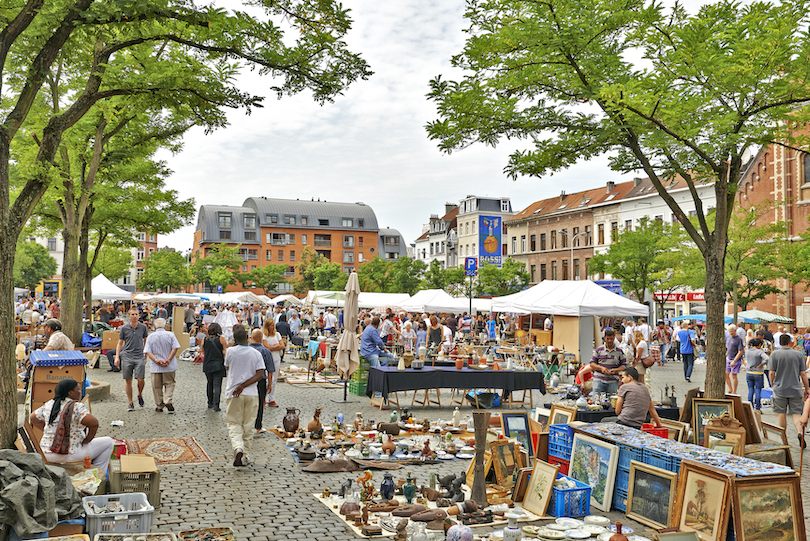
Also known as Vossenplein, The Place du Jeu de Balle is an historic square in the heart of the Marollen district. It is best known for a famous flea market that has operated there since 1873.
Fondly and appropriately referred to as the ‘Old Market’, this market is the only flea and antique market in the world to be open 365 days a year. When browsing through the various market stalls, you will find an eclectic mix of items for sale. They range from antique porcelain, vintage clothes and rare books to 19th-century crossbows, canvas artwork and old vinyl records.
The market is somewhere you can easily spend hours wandering around. Around the square, there are several shops you can browse in too.
26. Royal Museum of the Armed Forces and Military History
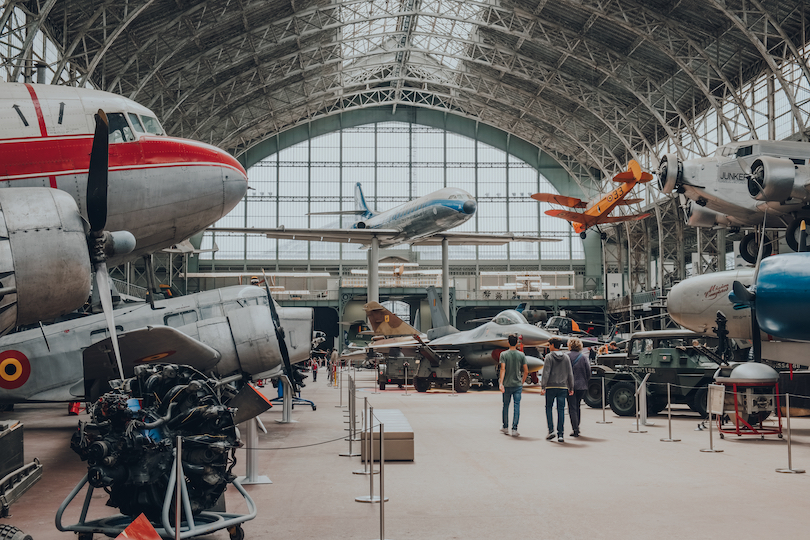
If you are fascinated by history and war, you will want to visit the Royal Museum of the Armed Forces and Military History.
Located within the historic Parc du Cinquantenaire, the captivating museum takes you on a journey from the Middle Ages to the dawn of the aviation age – focusing on battle, conflict and warfare. It showcases several galleries devoted to specific exhibits like the French empire, Russian Gallery and the Navy. Visitors can also take in its magnificent aviation hall and the arms and armour gallery.
Even if you are not a fan of the military or armed forces, it is worth coming here to see the outstanding panoramic views of Brussels from the top of the Triumphal Arch, which you can access from the museum.
25. Royal Theater Toone
If you are traveling to Brussels with children or should you want to unleash the big kid in you, be sure to visit the Théâtre Royal de Toone.
Locally known as Toone, this folkloric theater specializes in puppet shows. Founded in 1830 by Antoine ‘Toone’ Genty, it is now the only authentic marionette performance still operating in the city. Notably, many of the plays they present are in Marollien or Marols. The traditional dialect of Brussels.
During the performances, other languages are spoken. These shows customarily incorporate the essence of zwanze – a quintessential form of sarcastic humor that is distinctly Brusselian. As well as the shows, the theater has a small museum of puppetry and a tavern.
24. Comic strip murals
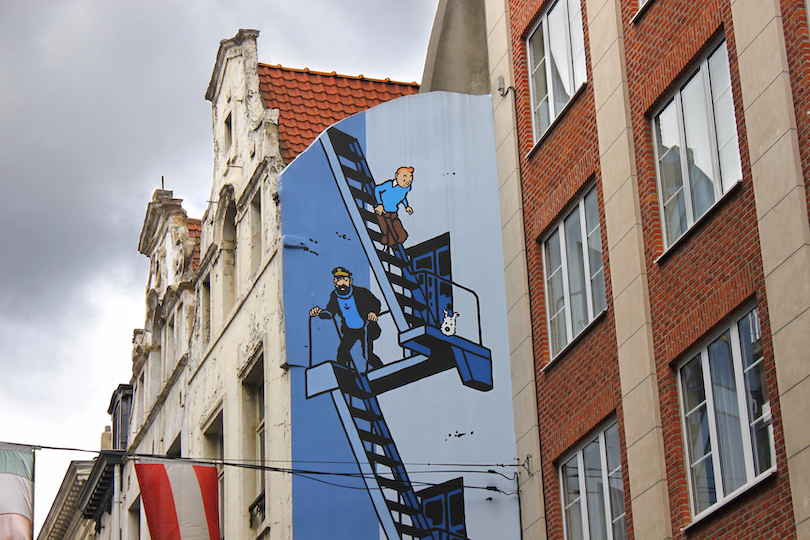
Brussels has been synonymous with comic books since Tintin and Spirou launched around the 1930s.
Although the city hosts the iconic comic book museum – the Belgian Comic Strip Centre – it also boasts several murals devoted to characters like Lucky Luck, The Smurfs, Gaston Lagaffe, Tintin and Spirou. These murals illuminate the side of buildings and are so prevalent you can even book a guided bike or walking tour to see some of the most popular ones.
If you prefer to tour them independently, pick up a map and head off for a self-guided exploration. Be sure to have your camera ready when you check out Brousaille Wall, Victor Sackville Wall, Le Jeune Albert Wall and Olivier Rameau’s Wall.
23. Bois de la Cambre
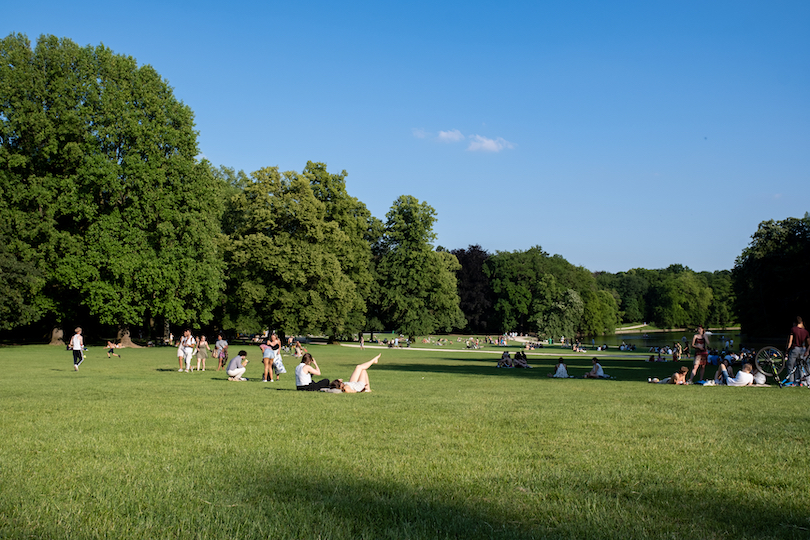
If you want to relax during your visit to Brussels, there is no better place to do this than at The Bois de la Cambre.
One of the larger public recreational spaces in the city, the park was named after La Cambre Abbey. Its layout is reminiscent of the manicured parklands of England and features immaculately cut grass and bosky woodland. There is a lovely path to go walking or jogging on, and children will enjoy the opportunity to play on the playground or go on a pony ride.
Set within the center of the park, Chalet Robinson sits on Robinson Island. There you will find a terrific restaurant and will be able to rent out pedalos or boats and partake in a friendly game of pétanque.
22. Horta Museum
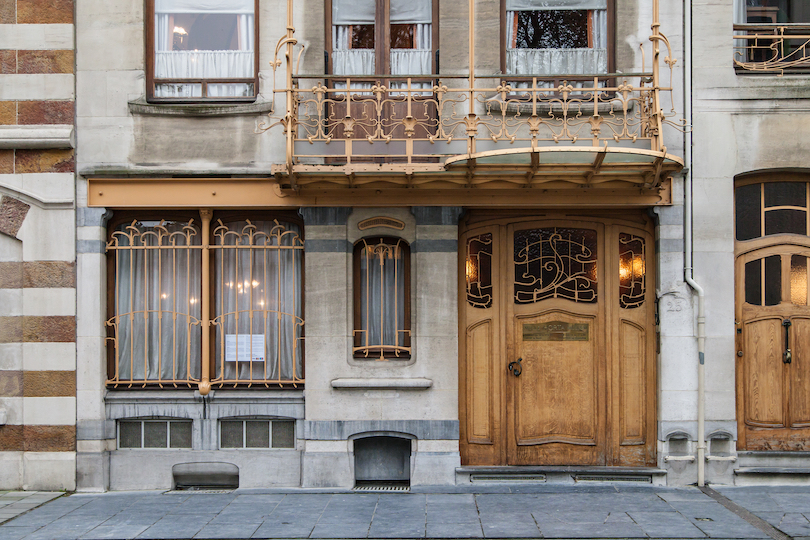
If you are a fan of the Art Nouveau movement, make sure you take the opportunity to visit The Horta Museum.
Situated on Rue Américaine, this museum is devoted to the life, vision, philosophy and work of the acclaimed architect Victor Horta. Presented in his former townhouse residence, which dates back to 1898, the museum features on UNESCO’s World Heritage list.
The museum showcases permanent displays of furniture, art objects and utensils. All of which were designed by Horta and his peers. You can also see documents that convey certain aspects of his life and the time. In addition, the museum showcases temporary exhibitions that further highlight the excellence of the man and his art. If you go there, be warned photography is not allowed in the museum.
21. Parlamentarium
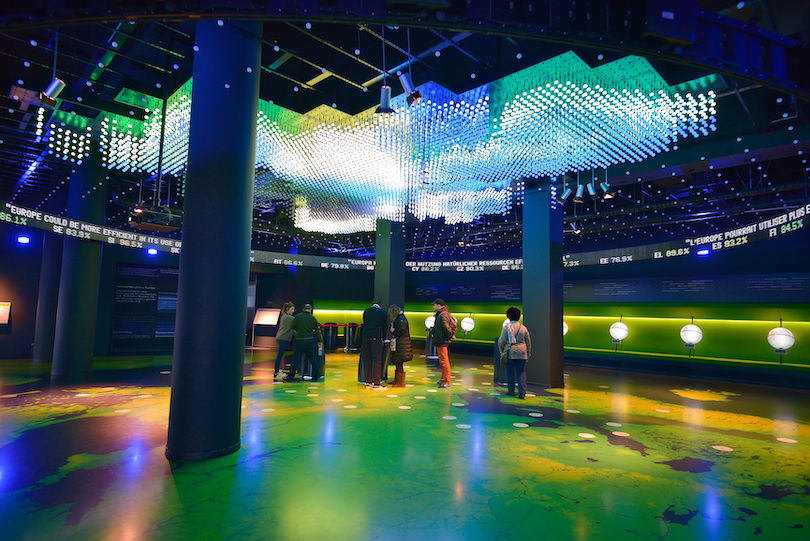
You might be aware of the European Parliament. But do you know what it does and how it may impact your everyday life? Well, if not, then you might want to pay a visit to the Parlamentarium.
Situated within the impressive Espace Léopold on Place du Luxembourg, this serves as the visitor center for the European Union. Opened in 2011, it features notable attractions like a role-playing game, a massive interactive floor map and a 360° cinema.
Whilst at the Parlamentarium, you can do a self-guided tour – which is available in 24 languages. During it, you will gain a deeper insight into the sometimes maligned institution and learn more about what they are doing to counter some of the continent’s most pressing issues.
20. Museum of Natural Sciences
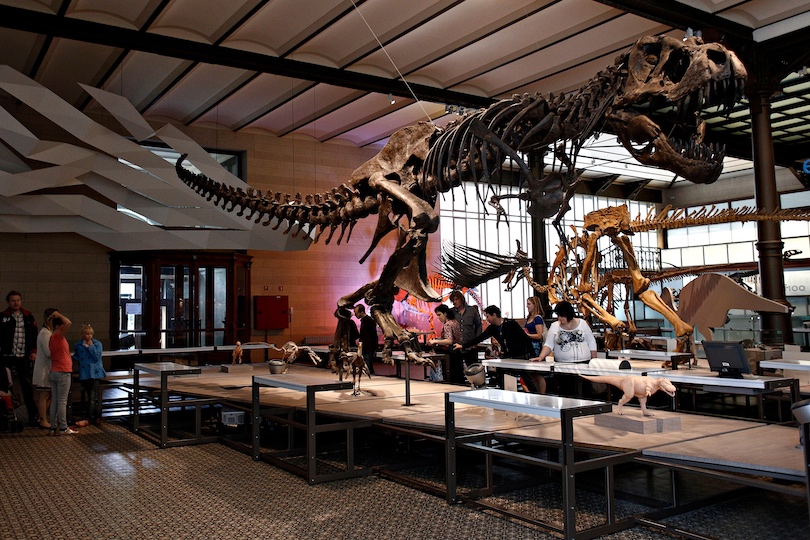
Are you fascinated by dinosaurs? Then pencil in a trip to the Museum of Natural Sciences.
You will have to head to Rue Vautier 29 to do so. But once you are there, you will experience the wonders of The Dinosaur Hall. Officially the largest museum hall in the world solely devoted to dinosaurs, it features the famous Ishango bone that the Belgian geologist Jean de Heinzelin de Braucourt discovered in 1960 in the Belgian Congo.
Incorporated within the Royal Belgian Institute of Natural Sciences, other exhibits at the museum include a collection of fossilized Iguanodon skeletons uncovered in 1878. Dinosaurs aside, you can discover more about the evolution of the human body in the Gallery of Humankind and travel back in time via the Gallery of Evolution too.
19. Cantillon Brewery
Belgium is renowned for the quality of its beer. So, if you are a fan of amber nectar, it would be churlish not to try a few local samples. One of the best places to do this in Brussels is on a tour of the Cantillon Brewery.
A traditional family-run brewery which opened in 1900, you’ll find it at Rue Gheude within the Anderlecht district of the city. It features original equipment and beer cellars used by Paul Cantillon, who founded the establishment.
Whilst there, you can tour their facility and try out some of their fabulous lambic-style beers. These include Kriek, a brew made with cherries, or Fou’ Foune, a beverage derived from apricot. If any beer takes your fancy, you can buy some from their shop.
18. Royal Museums of Fine Arts of Belgium
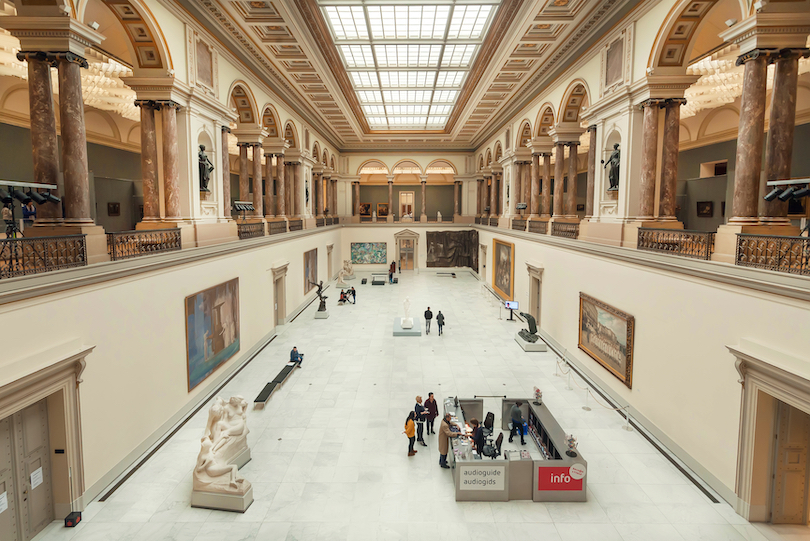
For art lovers, The Royal Museums of Fine Arts of Belgium should be a massive drawcard during your visit to Brussels. Comprising not one but six different museums, they collectively house some of the country’s most important cultural and artistic treasures.
The six institutions are the Magritte, Oldmasters, Antoine Wiertz, Constantin Meunier, Fin-de-Siècle and modern museum. Between them, these venues showcase an impressive collection of paintings, sculptures and drawings that date back to the early 15th century.
Exploring the complex of museums is among most popular things to do in Brussels. Expect to spend a lot of your time marveling at the works of celebrated artists like Robert Campin, Rogier van der Weyden, Anthony van Dyck, Bruegel, Peter Paul Rubens and Jacob Jordaens.
17. Autoworld
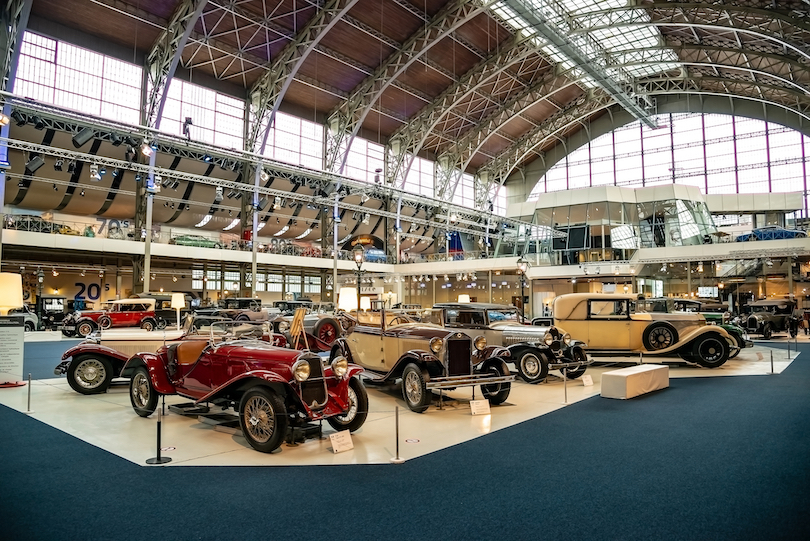
If you love cars, then Autoworld is somewhere you will have to visit when you go to the Parc du Cinquantenaire. Situated in the South Hall, this fantastic vintage car museum boasts a vast collection of automobiles from Europe and the USA.
The collection spans the late 19th century up until the 1990s. It features a Bentley made in 1928 and a Cord and Bugatti from 1930. It also presents Minervas and several limousines owned by the Belgian Royal Family.
In addition, several Belgian-made vehicles like Fondu, Vivinus, Imperia and FN are on display. Along with various other sports cars, passenger cars, motorcycles, carriages and fire engines. Throughout the year, the museum also runs celebrated events for the automotive industry.
16. Royal Palace
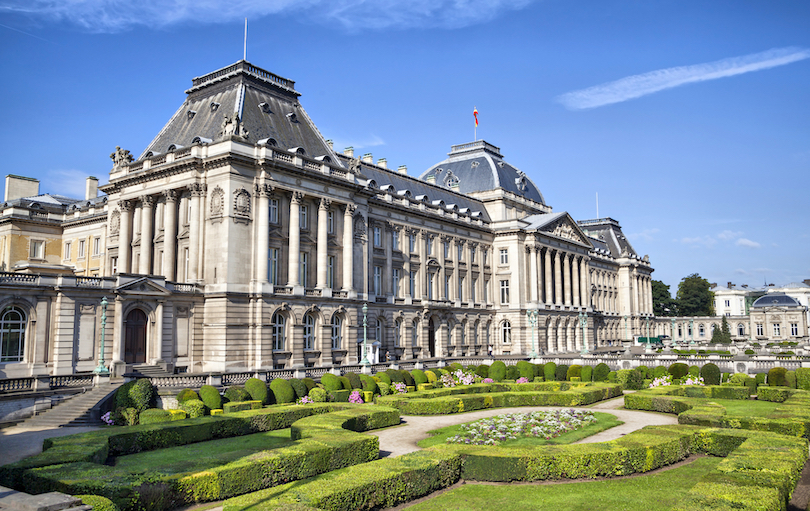
Separated from Brussels Park by a stately square called Place des Palais, the Royal Palace is one of the city’s most impressive examples of Neoclassical architecture. As construction started in 1783 and was not completed until 1934, this should give you an idea of how expansive the building is.
Although it is the official palace of the Belgian monarchy, the king and queen do not use it as their royal residence. However, as is tradition, they open their doors to the general public for five weeks every year in July and August.
At this time, you can visit it for free and gain access to certain rooms. Some of these rooms contain state portraits of Leopold I, Napoleon, Leopold II and Louis Philippe I.
15. Serres Royales De Laeken
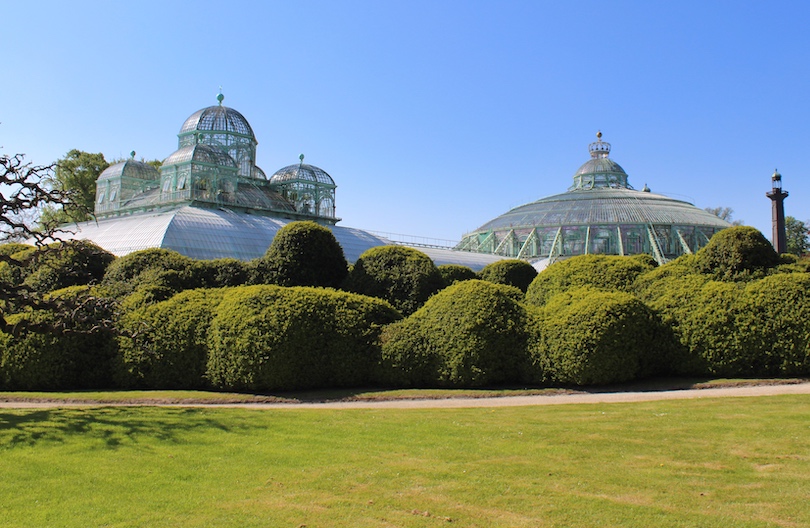
Brussels can get a bit nippy in the winter. So, a good place to escape this chill is The Royal Greenhouses of Laeken.
Located within the Avenue du Parc Royal, this magnificent complex of classically designed, heated greenhouses features tropical, sub-tropical and cold zones. Created in 1874 on behalf of King Leopold II, under the jurisdiction of Alphonse Balat, the complex also features arcades, pavilions and several cupolas.
It now belongs to the Belgian Royal Family, who only open it to the general public a handful of days in the year. If you can visit it when it is open, you should see its famous Royal Botanic Collection. It includes the world’s oldest and largest collection of camellias cultivated in a greenhouse setting.
14. Parc du Cinquantenaire

As previously mentioned, The Parc du Cinquantenaire is home to The Royal Museum of the Armed Forces and Military History. However, there is much more than that to Jubelpark – as it is colloquially known.
The beautiful green space covers 30 hectares within the eastern part of the city’s European Quarter. It was inaugurated in the 19th century and has beautifully landscaped grounds with fountains, ponds, waterfalls and floral gardens.
The park features a U-shaped building complex that houses numerous institutions of high cultural relevance. These include a centerpiece memorial arch, the Art & History Museum and the Autoworld vintage car. It also features a monument dedicated to Belgian Pioneers in the Congo, The Temple of Passions and the Great Mosque of Brussels.
13. Rene Magritte Museum
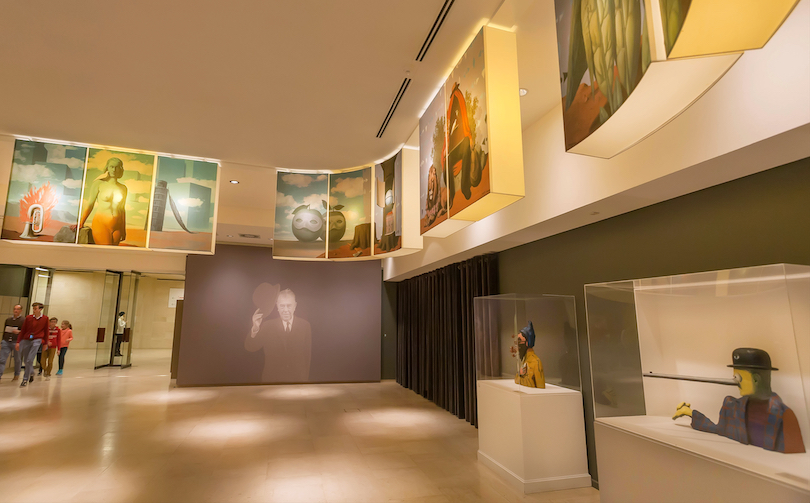
Art lovers should make a point of visiting the Magritte Museum. Situated on the Palace Royale, within the exquisite, neoclassical, five-storey Hôtel du Lotto, this terrific attraction presents the work of René Magritte.
An acclaimed Belgian surrealist artist, the museum features a permanent, multidisciplinary collection of his original drawings, paintings and sculptures. Amongst the notable works on display are ‘The Empire of Light’, ‘Scheherazade’ and ‘The Return’.
The museum serves as one of the Royal Museums of Fine Arts of Belgium’s constituents. It is the largest archive of Magritte’s work anywhere in the world, with much of it coming from his widow’s private collection. Other exhibits include photography and short surrealist films that Magritte experimented on.
12. Train World
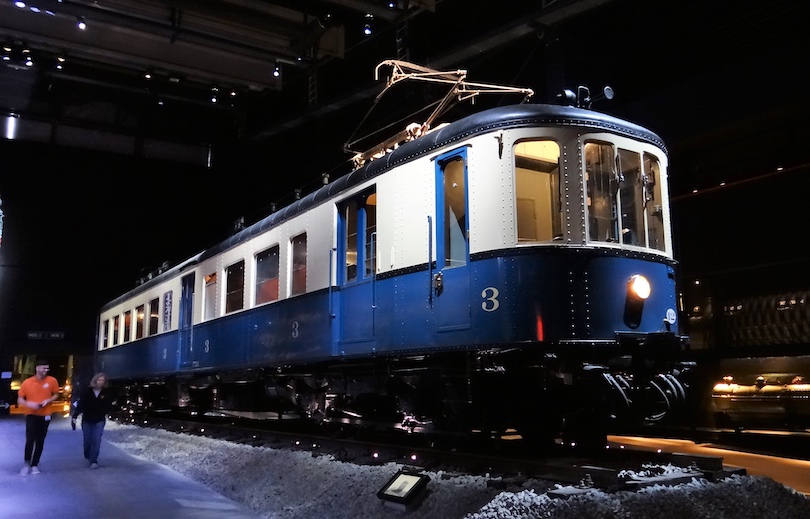
If you are into ferroequinology, your first stop in Brussels should be a trip to Train World.
Tucked away in the renovated buildings of the former Schaarbeek railway station, this attraction is the Belgian National Railway Company’s official museum. Overall it presents iconic steam locomotives like Le Belge and ‘L’Eléphant’, both built in 1835, and the Pays de Waes (1844). It also exhibits a railway bridge built in the 19th century and even provides an experience of what driving a train feels like.
Found at Place Princesse Elisabeth, the museum is open every day of the week except Monday. There is a restaurant onsite in case you get hungry, and you can rent audio guides in different languages whilst you are there.
11. Belgian Comic Strip Center
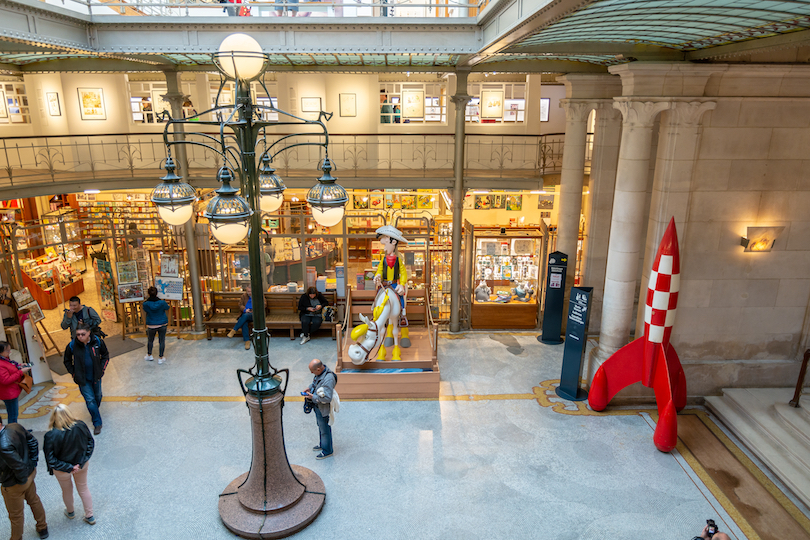
If you’ve seen the comic strip murals, then you should be ready to visit the Comics Art Museum. If you make it down to its Rue des Sables 20 location, you will see another Victor-Horta-designed Art Nouveau building.
For over 30 years, this terrific attraction has been championing the leading players and characters of the 9th Art. it spans four floors, and there is plenty to see here. The first floor has a comic store, library, study center, restaurant and a room honoring Victor Horta.
The first floor comprises rooms with original pages of comic books and animation, as well as an auditorium. Whilst the second has a permanent exhibition of characters and publications. The top floor is devoted to merchandising.
10. Notre Dame du Sablon
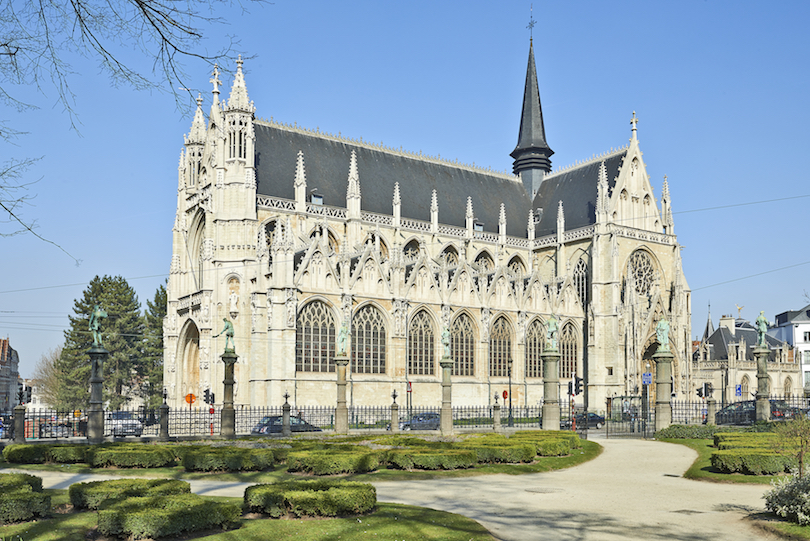
Notre Dame du Sablon is a lovely 15h century Gothic Catholic church located in the historic Sablon district of Brussels. Also known as Our Blessed Lady of the Sablon, church parishioners included Belgium’s royalty and nobility. Indeed, some royals are buried in the chapel of St. Ursula.
This gray-white church is famous for its beautiful stained glass windows that are illuminated from the inside at night. Other must-sees are the two baroque chapels with funeral symbols carved into the marble and the statue of St. Hobart that once was stolen by Antwerp and recaptured by Brussels in 1348.
9. Mini Europe
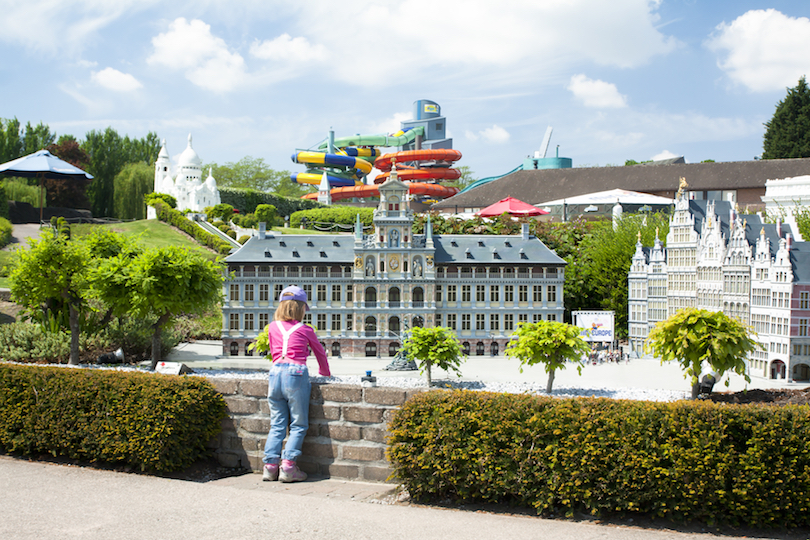
A visit to Mini Europe may remind many people of the old movie, “If it’s Tuesday, it must be Belgium,” in which travelers make the Grand Tour of Europe in just a few days. At Mini Europe, however, they can see the best on the continent in just a few hours.
A tour of Mini Europe will take visitors from the gondolas of Venice to Big Ben in London. They can also experience Vesuvius erupting in Italy and the fall of the Berlin Wall in Germany. In all, Mini Europe offers 350 miniature settings that explore the best of Europe.
8. Musical Instrument Museum
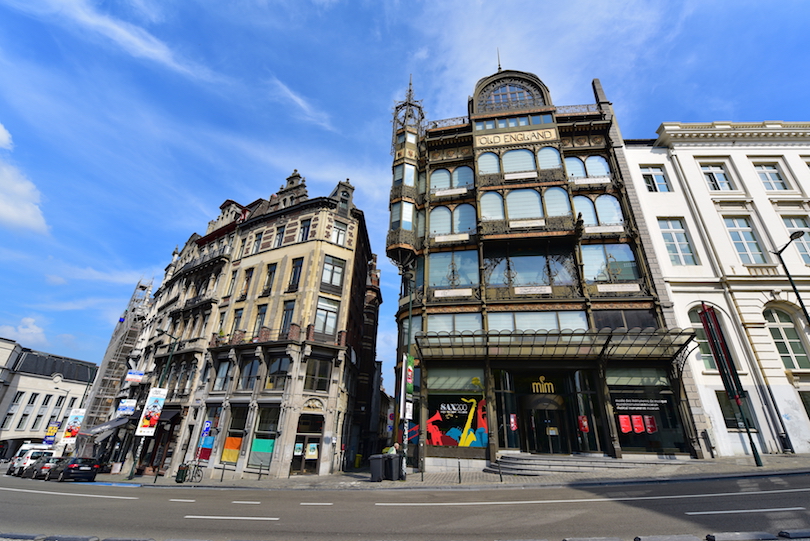
The Musical Instrument Museum is a must-visit for anyone who plays a musical instrument or just plain loves music. The museum houses more than 1,100 musical instruments, ranging from ancient to modern.
Considered one of the top musical instrument museums in the world, the museum also houses a concert hall in its uniquely designed Art Noveau and Neoclassical building. Exhibits feature keyboards, types of music from medieval to the 19th century, and mechanical and electronic instruments.
The most popular gallery features traditional musical instruments from around the world. Here, visitors may be surprised to learn the Scots weren’t the only ones who played bagpipes.
7. Galeries Royales Saint-Hubert
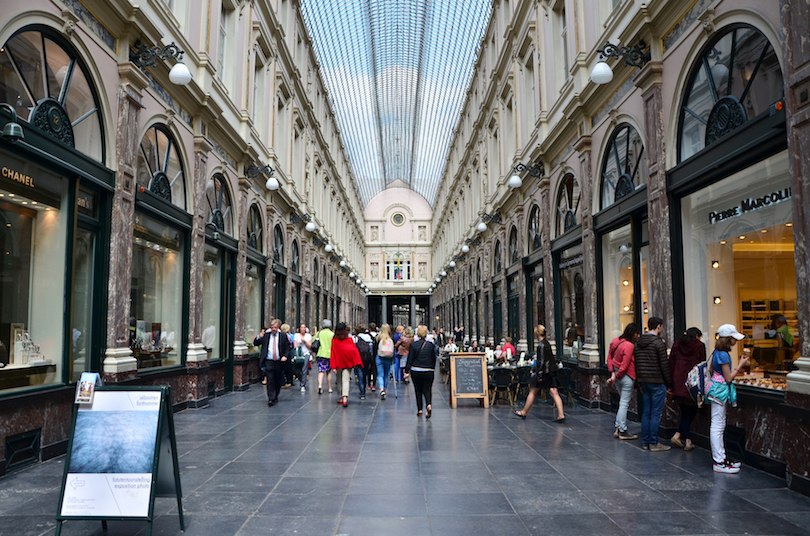
In a city replete with incredible architecture, it is a testament to how the design of The Royal Saint-Hubert Galleries manages to capture people’s attention.
Lording over the Galerie du Roi 5, just a stone’s throw from the Grand Place, it takes the form of a trio of ornate, glazed shopping arcades. Consisting of the King’s, Queen’s and Prince’s galleries, they opened in 1847 after being designed and constructed under the project management of Jean-Pierre Cluysenaer.
Representing the Italianate Cinquecento style, this historic monument features shopfronts with glazed arches separated by two upper floors and pilasters. Among the many upscale retailers are Neuhaus chocolatiers and the revered Delvaux leather goods. The Royal Theater of the Galleries is also within the complex.
6. Mont des Arts
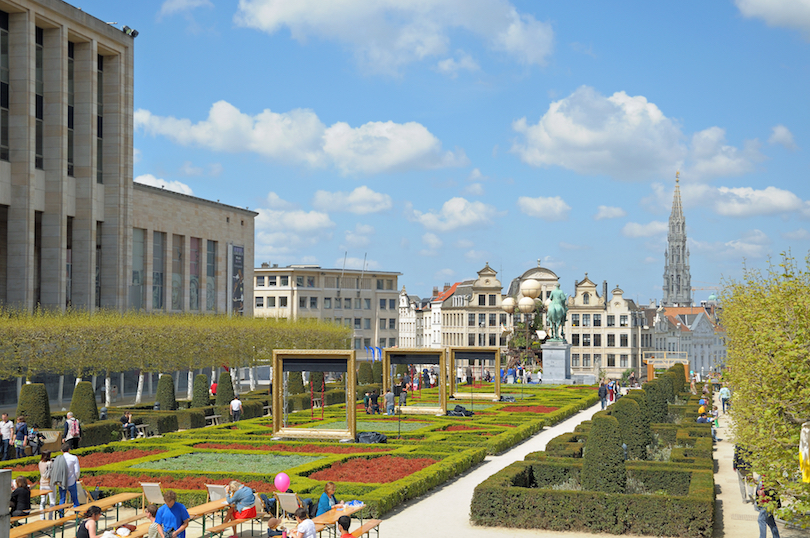
Cats may have nine lines, but the Mont des Arts, a hill in the center of Brussels, is giving them a run for the money. Once a densely populated neighborhood, the buildings were torn down; the land lay vacant for many years. Then a garden was put in but it, too, was torn down to make way for buildings, which include the Royal Library and Congress Palace.
A new garden shares space with the buildings today. Visitors to the “hill of the arts” will find some of the best views of Brussels from here, with the Town Hall spires reaching up into the sky.
5. Manneken Pis
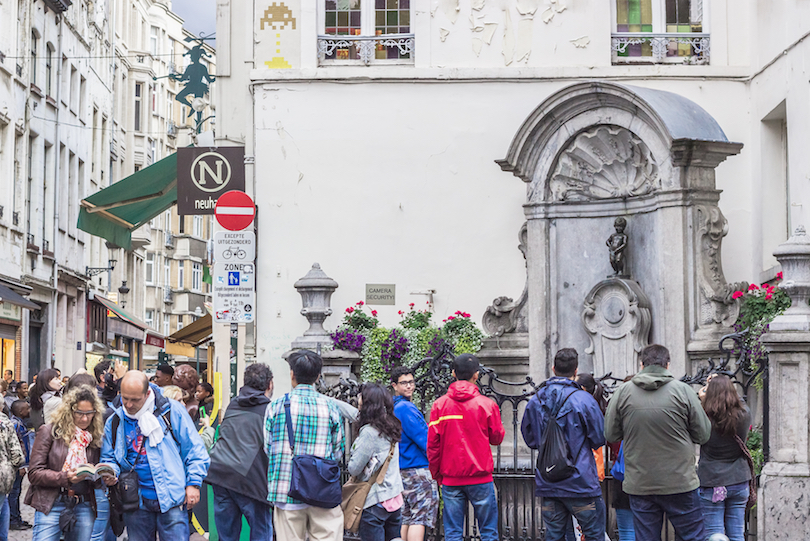
The Manneken Pis is undoubtedly the most visited landmark in Brussels. While visitors may skip many of the fine museums, no one leaves Brussels without visiting the Manneken Pis: a unique water fountain that features a naked little boy urinating into a fountain.
The statue isn’t always naked, however, as it has a wardrobe that would make the Kardashians jealous: It has 900 costumes that are changed frequently. Visitors can view them at the City Museum. The small bronze statue has been amusing residents and visitors alike since the early 1600s, though there is mention of such a statue a century or two earlier.
4. Brussels Cathedral
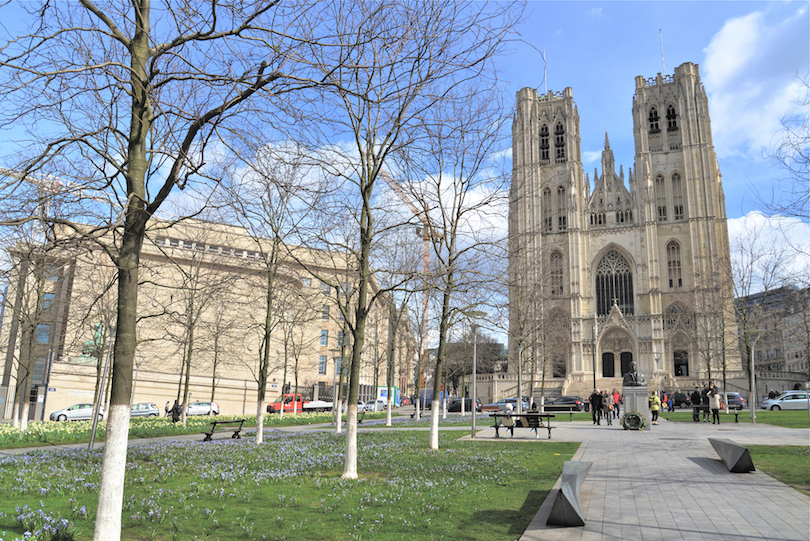
The Brussels Cathedral, formally known as the Cathedral of St. Michael and St. Gudula is a truly magnificent structure. The main part of this Catholic chuch dates to the 11th century while the towers were constructed in the 13th century. All told, it took about 300 years to build this impressive stone church.
Named after the country’s patron saints, it is Belgium’s main church. Visitors will be awed by the beautiful stained glass windows, especially the ones by Bernard van Orley, a 16th century painter. The Last Judgment window is lit from within at night.
3. Town Hall
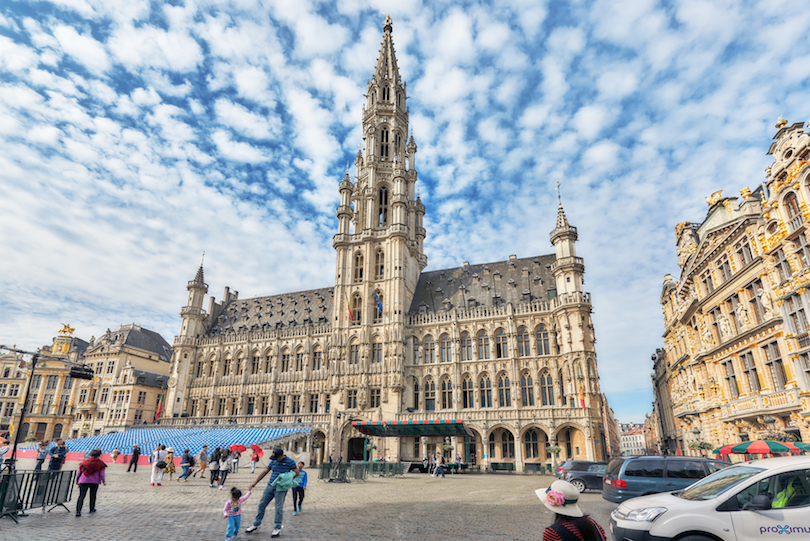
While many cities rush to build modern town halls, the City of Brussels is sticking with its early 15th century Gothic town hall. It is the last remaining medieval building on the Grand Place. Of course, there’s a newer addition, but it’s not as interesting.
The old town hall is decorated with 137 statues of important people, like nobles and saints, in the city’s history. Visitors will only see copies there, as the originals are in the nearby city museum. The building is topped with an elegant spire that itself is topped with a 5-meter (16-foot) high statue of the archangel Michael.
2. Atomium
At first glance, the Atomium looks like a space-age Ferris wheel, but looks can be deceiving. This Brussels landmark actually represents a portion of an ion crystal that’s been magnified 185 billion times.
Built in 1958 as the main pavilion for the Brussels’ world fair, it was named the world’s most bizarre building in 2013 by CNN. But beauty is in the eye of the beholder, and the Belgians love it.
The Atomium consists of nine spheres, only six of which are open to the public. An elevator takes people to the top of the structure, but otherwise visitors travel between the spheres on escalators.
1. Grand Place

The Grand Place is indeed grand. As the city’s central square, it is a most visited landmark, home to two of the main attractions in Brussels, the Town Hall and City Museum, as well as former guildhalls. Also known as Grote Markt, the Grand Place was a major market place that dates back to the 10th century.
The large square is filled with a carpet made from flowers every second August. Today it’s lined with many cafes, making it a good place to sample traditional Brussels’ foods, such as moules (mussels), waffles and french fries, which originated in Belgium, not France.


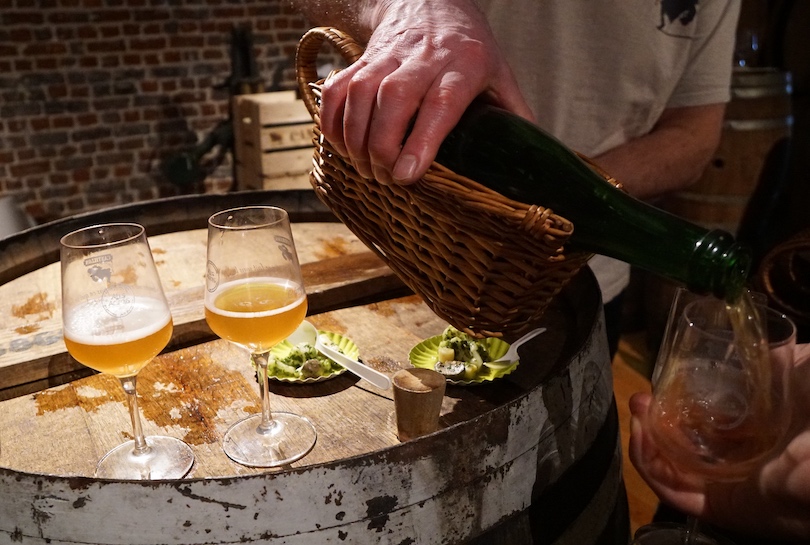
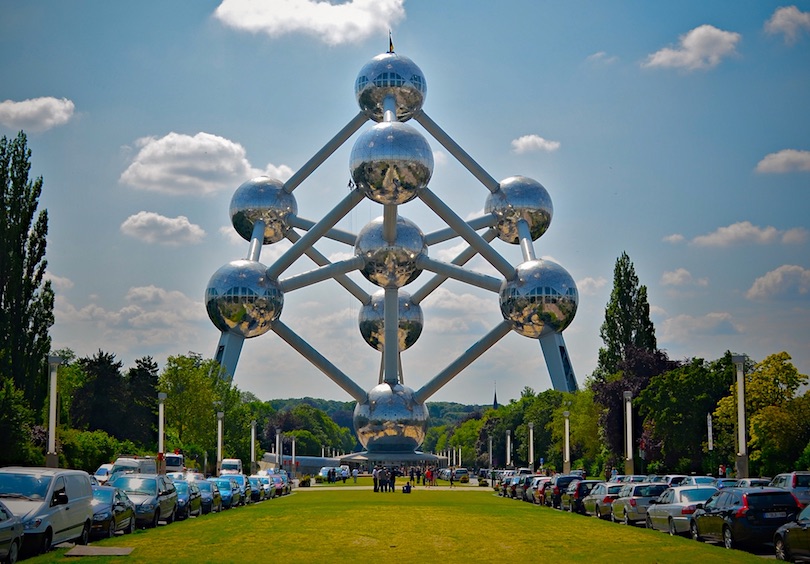
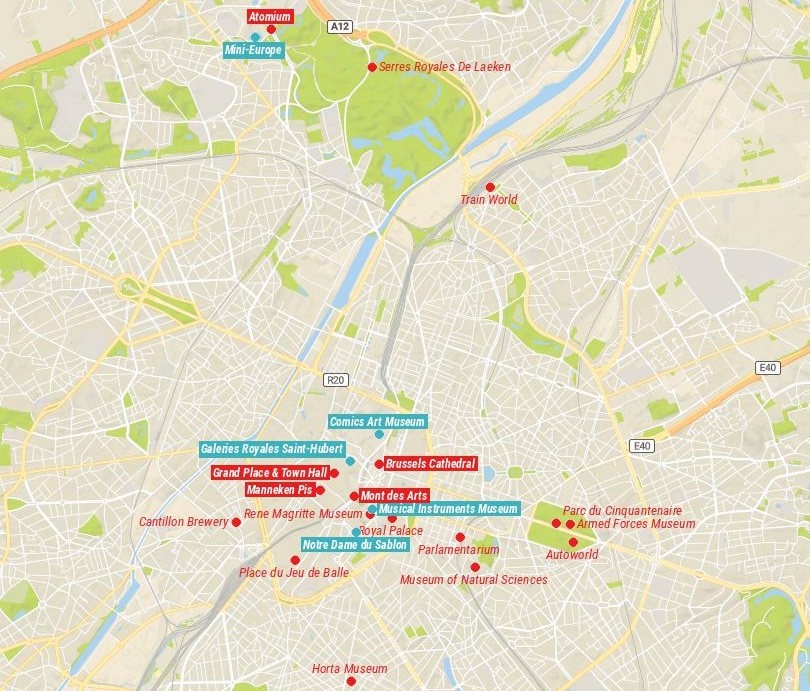
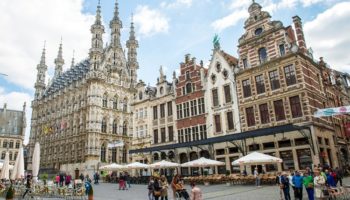
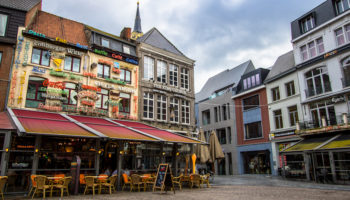
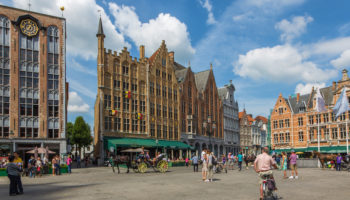

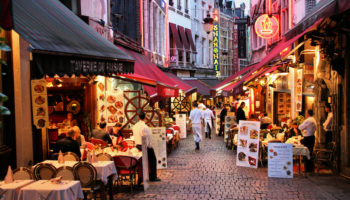
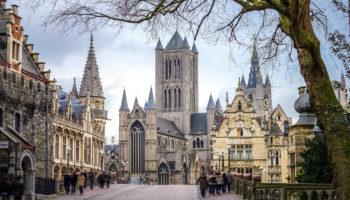
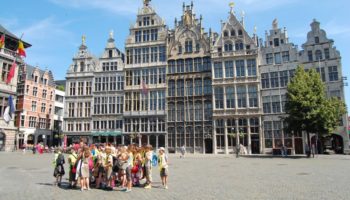
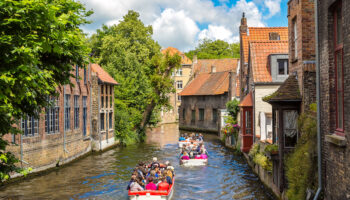
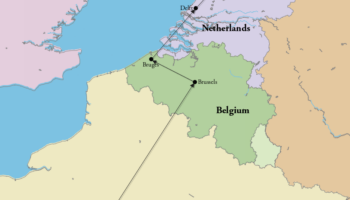
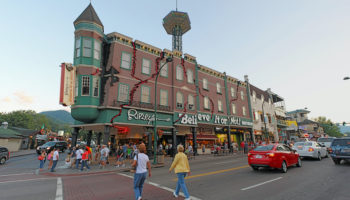

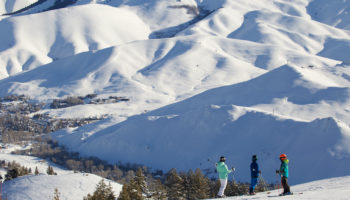
Just so you know, the Musical Instruments museum is not very tourist friendly if you don’t speak one of the three languages in Belgium. I lived in Belgium for 6 years and visited two years ago with a friend, and found that there was nothing written in English. Therefore, I had act like a translator for a friend. Also fun fact: there is also a peeing dog and a peeing girl statue in Brussels.
If I can recommend one more thing to add to the list, it would be the Magritte Museum. Fantastic art museum of the famous surrealist painter.